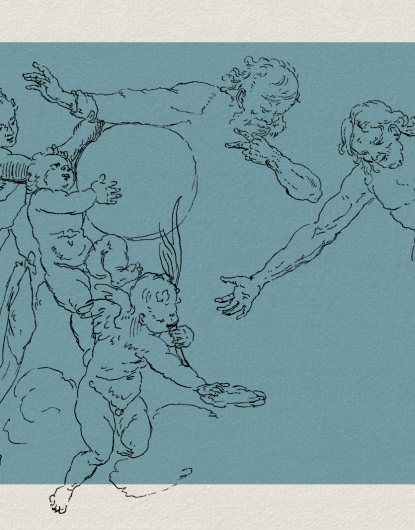Virtuosity of Line. Andrzej Radwański (1711-1762)
The drawings of the Kraków painter, Andrzej Radwański (1711–1762), are mostly made with a pen or a fine brush dipped in black, brown, or sometimes blue ink. The artist built the silhouettes of the figures with an uneven, sharply broken line, and achieved the impression of space with the frequent use of wash – touching up the drawings with diluted ink – and hatching techniques. His works – which can be divided into initial and conceptual sketches, preparatory and design drawings, copies of engravings, and studies of other art works (including sculptures) – testify to the artist’s broad creative horizons and openness to examples from the art world. One such example are his studies of stucco decorations in the Church of St Anne in Kraków, created in 1738, which point to several important aspects of Radwański’s painting practice. Although the study of sculptures was an element of the academic practice of teaching drawing in Europe at the time, it had no precedent in the Kraków painters’ guild. In Radwański’s case it can be explained by the painter’s broad intellectual interests, which were unique for an apprentice of that era. The artist consciously transferred sculpted figures to paper, learning anatomy, proper proportion, and chiaroscuro.
The design drawings Radwański used in his Kraków commissions are of immense importance for his oeuvre. Although the painter’s activity took place in the period when an economically and culturally declining Kraków was becoming less relevant than the thriving Warsaw, an increased foundational activity had been noticeable in the city since the 1830s. Monumental decorations, one of the most frequent forms unifying church interiors, played a significant role in sacral foundations. In line with the Baroque concept of unity in art – including architecture, sculpture, and painting – these new paintings gave the medieval temples a Late Baroque expression, a model example of such a transformation being St Mary’s Basilica. In 1748–51, Radwański was commissioned by Fr Jacek Augustyn Łopacki to create paintings that would cover almost the entire interior of the church, and he also entrusted Radwański with creating the paintings in Wawel Cathedral. Both artistic creations can be counted among the most prestigious in the city. Soon after that, in 1756, the artist was contractually engaged by the prioress, Urszula Lubomirska, to renew the existing decorations and create new ones for the Church of the Visitation Sisters. The Church of St Francis of Assisi also gained a Baroque décor thanks to Radwański (1757–59). At the same time the painter carried out works in the Chapel of St Hyacinth (Jacek) in the Dominican Basilica of Holy Trinity, and in 1758–59 – commissioned by a Kraków councillor, Awedyk – he created decorations in the Church of St Adalbert.
Unfortunately, most of Radwański’s monumental paintings were destroyed during the great fire of Kraków of 1850, and those that survived were painted over, leaving us with no idea of their original character. As a result, Radwański’s name was forgotten.
The design drawings Radwański used in his Kraków commissions are of immense importance for his oeuvre. Although the painter’s activity took place in the period when an economically and culturally declining Kraków was becoming less relevant than the thriving Warsaw, an increased foundational activity had been noticeable in the city since the 1830s. Monumental decorations, one of the most frequent forms unifying church interiors, played a significant role in sacral foundations. In line with the Baroque concept of unity in art – including architecture, sculpture, and painting – these new paintings gave the medieval temples a Late Baroque expression, a model example of such a transformation being St Mary’s Basilica. In 1748–51, Radwański was commissioned by Fr Jacek Augustyn Łopacki to create paintings that would cover almost the entire interior of the church, and he also entrusted Radwański with creating the paintings in Wawel Cathedral. Both artistic creations can be counted among the most prestigious in the city. Soon after that, in 1756, the artist was contractually engaged by the prioress, Urszula Lubomirska, to renew the existing decorations and create new ones for the Church of the Visitation Sisters. The Church of St Francis of Assisi also gained a Baroque décor thanks to Radwański (1757–59). At the same time the painter carried out works in the Chapel of St Hyacinth (Jacek) in the Dominican Basilica of Holy Trinity, and in 1758–59 – commissioned by a Kraków councillor, Awedyk – he created decorations in the Church of St Adalbert.
Unfortunately, most of Radwański’s monumental paintings were destroyed during the great fire of Kraków of 1850, and those that survived were painted over, leaving us with no idea of their original character. As a result, Radwański’s name was forgotten.

access to the exhibition

